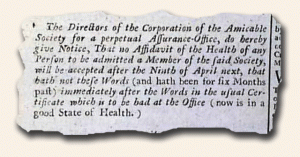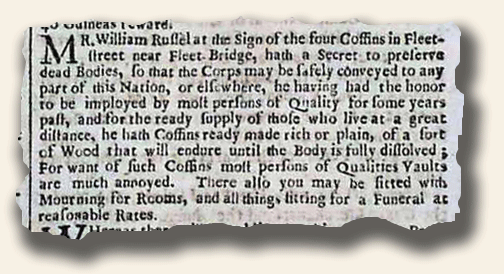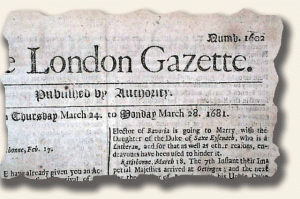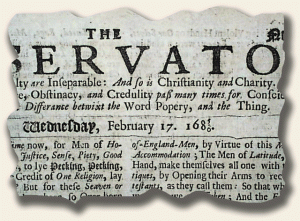Entry point to the Rare Newspapers Collectible… 16th & 17th Centuries…
February 17, 2011 by GuyHeilenman · 2 Comments
Our peek at the lower-end entry points into the hobby of collecting rare and early newspapers draws to a conclusion today with a gander at inexpensive newspapers published prior to 1700. A list of titles priced at under $50 includes: The London Gazette, The Athenian Mercury, Votes of the House of Commons, The Observator, and The Weekly Pacquet of Advice From Rome, all of which are British publications.
The following link will take you to these potential pre-1700 entry-point issues: Pre-1700 Inexpensive Issues
Enjoy!
Note: View the following to explore the History’s Newsstand Blog’s featured posts on the upper end of the collectible: “Prices Realized” and “Most Collectible Issues“.
The Traveler… traveling to Rio de Janeiro… part of the “health test”??
February 10, 2011 by The Traveler · 1 Comment
 I decided to take my travels a like further back in time and to a place that always intrigued me. Through letters from Boston and Philadelphia, The London Gazette dated February 12, 1711 reported on a vessel that had been shattered from Rio de Janeiro. The French had landed and were being beaten off with the reinforcement of eight thousand men from the mines… the French retreated.
I decided to take my travels a like further back in time and to a place that always intrigued me. Through letters from Boston and Philadelphia, The London Gazette dated February 12, 1711 reported on a vessel that had been shattered from Rio de Janeiro. The French had landed and were being beaten off with the reinforcement of eight thousand men from the mines… the French retreated.
In my readings, I see numerous “An Act..” within newspapers, but found this one quite unusual. “An Act to enable John Lord Gower, Baron of Stitnham, an Infant, to make a Settlement upon his Marriage.” I wonder what the terms of the settlement were??
Last, the back page had an announcement about “The Corporation of the Amicable Society for the Perpetual Assurance-Office” for the Affidavit of the Health. The way the announcement read, this may have been part of the qualification testing… if you understood it all, then you were in good (mental) health.
~The Traveler
Walmart sells them too…
December 12, 2009 by TimHughes · Leave a Comment
A 1685 issue of the “London Gazette” newspaper contains on the back page the following interesting advertisement, not the type typically found in newspapers–at least not in more modern times. Interesting that the coffin maker notes that he makes them: “…of a sort of wood that will endure until the body is fully dissolved…”.
I saw a piece recently where Walmart now sells coffins on-line. And just in time for Christmas:

Double-dated newspapers: the Julian and Gregorian calendars…
April 9, 2009 by TimHughes · 1 Comment
 If you have some 1600’s newspapers in your collection you may have a few with dates showing years as “1683/4″ or 1686/7”, or perhaps you have a few issues from a single year where a later date has an issue number lower than an earlier date, and you’ve wondered “how could this be?” Well, it’s due to the calendar, or more specifically which calendar was in use at the time.
If you have some 1600’s newspapers in your collection you may have a few with dates showing years as “1683/4″ or 1686/7”, or perhaps you have a few issues from a single year where a later date has an issue number lower than an earlier date, and you’ve wondered “how could this be?” Well, it’s due to the calendar, or more specifically which calendar was in use at the time.
Although the differences between the older Julian calendar and our current Gregorian calendar are many and very complicated and can be understood by visiting this site, the short answer is that in the latter part of the 17th century & a portion of the 18th century both calendars were in use in England, and the date of the issue would reflect which calendar was in use.
 The new year of the older Julian calendar began on March 21, so an issue dated March 17, 1675 would be followed by the next weekly issue dated March 24, 1676. This would also mean that an issue dated December 31, 1675 would be followed by an issue dated January 7,1675. This was how the London Gazette dated it’s issues for much of the 17th and early 18th centuries. At first glance one would think that the issue of Jan. 7, 1675 was older than one dated December 31, 1675, but the opposite was true.
The new year of the older Julian calendar began on March 21, so an issue dated March 17, 1675 would be followed by the next weekly issue dated March 24, 1676. This would also mean that an issue dated December 31, 1675 would be followed by an issue dated January 7,1675. This was how the London Gazette dated it’s issues for much of the 17th and early 18th centuries. At first glance one would think that the issue of Jan. 7, 1675 was older than one dated December 31, 1675, but the opposite was true.
 Other titles were a bit more helpful in noting the year of publication by dating issues from January 1 thru March 20 with a double-dated year such as “1684/5” or “1686/7” so the reader would know that it was from the year 1684 under the Julian calendar, or 1685 under the Gregorian calendar.
Other titles were a bit more helpful in noting the year of publication by dating issues from January 1 thru March 20 with a double-dated year such as “1684/5” or “1686/7” so the reader would know that it was from the year 1684 under the Julian calendar, or 1685 under the Gregorian calendar.
Some American newspapers of the 18th century have similar double dates, but by the beginning of the 19th century–if not reasonably before–newspapers had converted exclusively to the Gregorian calendar. The same was true with most of the Western world, while other portions of the globe adopted the Gregorian dating system much later.
Hopefully this answers a few questions you have had. Be in touch if we can be more helpful!
Weaponry in the 17th century… distant cousin of the modern hand grenade…
November 28, 2008 by Historys Newsstand · Leave a Comment
 One of the key issues featured in our latest catalog is a newsbook of the Mercurius Politicus, from London, dated March 24, 1659. Newsbooks, for those unfamiliar with the term, were the forerunners of newspapers. This particular newsbook measures about 8 1/2 by 6 3/4 inches and has 16 pages. While looking for interesting content to describe, I noticed a report datelined “Marienburgh, March 5”, that contained details about a military engagement. In the report is word that: “..Colonel Drake came with a party back, fetching from hence Morter pieces, Balls, Handgranadoes, and other amunition, and is gone back to the army which lyeth near Rysenburgh…” In reading this passage I was fascinated by the term “Handgranadoes“. I did some research and discovered that the concept of “throwing” grenades may date to the Ming Dynasty in China, although the first known use of grenades occurred during the early to middle part of the 8th century. The research also suggested that some “Medieval petards” were small enough to be considered primitive hand grenades. Later, during the Song Dynasty, Chinese soldiers began to pack gunpowder into ceramic and metal containers, resulting in what one expert determined to be the prototype of the modern hand grenade. Variations of this prototype eventually appeared in Europe during the late 1460’s. About 200 years later,
One of the key issues featured in our latest catalog is a newsbook of the Mercurius Politicus, from London, dated March 24, 1659. Newsbooks, for those unfamiliar with the term, were the forerunners of newspapers. This particular newsbook measures about 8 1/2 by 6 3/4 inches and has 16 pages. While looking for interesting content to describe, I noticed a report datelined “Marienburgh, March 5”, that contained details about a military engagement. In the report is word that: “..Colonel Drake came with a party back, fetching from hence Morter pieces, Balls, Handgranadoes, and other amunition, and is gone back to the army which lyeth near Rysenburgh…” In reading this passage I was fascinated by the term “Handgranadoes“. I did some research and discovered that the concept of “throwing” grenades may date to the Ming Dynasty in China, although the first known use of grenades occurred during the early to middle part of the 8th century. The research also suggested that some “Medieval petards” were small enough to be considered primitive hand grenades. Later, during the Song Dynasty, Chinese soldiers began to pack gunpowder into ceramic and metal containers, resulting in what one expert determined to be the prototype of the modern hand grenade. Variations of this prototype eventually appeared in Europe during the late 1460’s. About 200 years later,  “Grenadoes”, according to a Wikipedia source, were used during the English Civil War (1642-1651). The source also says: “The word ‘grenade’ originated in the Glorious Revolution (1688), where cricket ball-sized iron spheres packed with gunpowder and fitted with slow-burning wickets were first used against the Jacobites in the battles of Killiecrankie and Glen Shiel. These grenades were not very effective….and, as a result, saw little use.” Obviously the mention of “handgranadoes” in the newsbook report confirms the use of such a weapon during the mid 1600’s. More importantly, this may be one of the earliest references to a distance cousin of the modern hand grenade to appear in newsprint. Note: The term “grenadier”, which is derived from the word grenade, was a classification given to soldiers in the 17th century with the specific role of throwing grenades. You simply never know what you might find while perusing collectible newspapers (and newsbooks).
“Grenadoes”, according to a Wikipedia source, were used during the English Civil War (1642-1651). The source also says: “The word ‘grenade’ originated in the Glorious Revolution (1688), where cricket ball-sized iron spheres packed with gunpowder and fitted with slow-burning wickets were first used against the Jacobites in the battles of Killiecrankie and Glen Shiel. These grenades were not very effective….and, as a result, saw little use.” Obviously the mention of “handgranadoes” in the newsbook report confirms the use of such a weapon during the mid 1600’s. More importantly, this may be one of the earliest references to a distance cousin of the modern hand grenade to appear in newsprint. Note: The term “grenadier”, which is derived from the word grenade, was a classification given to soldiers in the 17th century with the specific role of throwing grenades. You simply never know what you might find while perusing collectible newspapers (and newsbooks).


